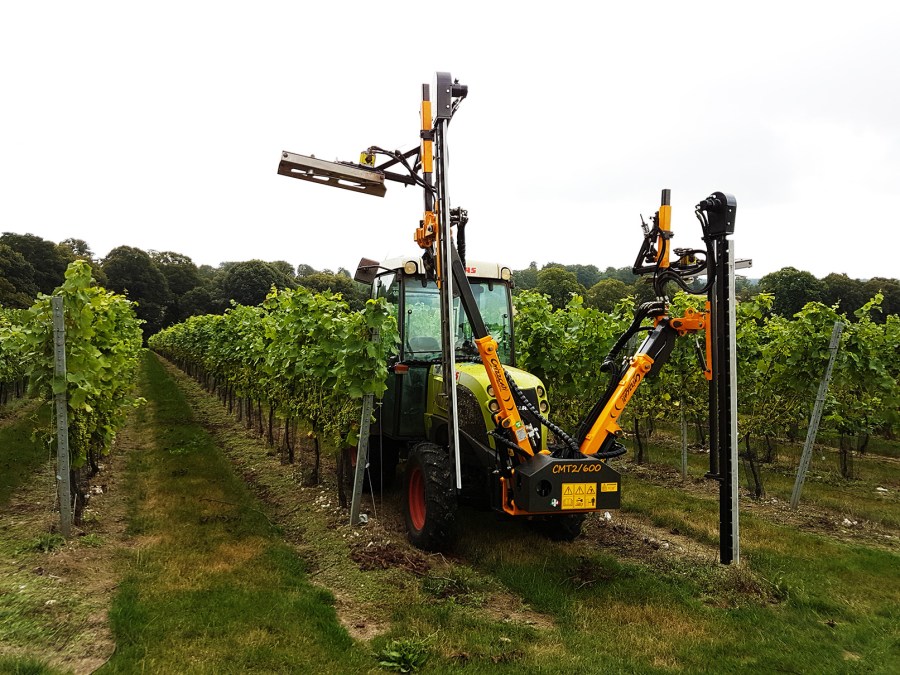Very soon vineyards will be in the ‘thick of it’ as rapid vegetative growth can result in dense untamed canopies. Vineyard finds out from some of the UK’s leading vineyard managers their techniques, timings and methods for leaf removal in the quest to achieve vine balance.
One of the many challenges for vineyard managers, especially in high vigour sites, is achieving vine balance, with just the right amount of vegetative growth to ripen the appropriate crop load. Too much vegetative growth can result in a damp microclimate and a favourable environment for fungal diseases – but too few leaves reduce the leaf area for light interception and photosynthesis. Leaf removal by hand is effective but labour intensive, but there is now a range of mechanical options for leaf removal and vine trimming.
“Achieving vine balance is an ongoing task throughout the season, starting with winter pruning, sucker removal, shoot thinning and positioning, leaf removal, trimming, and cluster thinning,” explained Duncan McNeill, Viticulturist. “In my experience leaf removal – and most importantly its timing – is a key aspects of canopy management and critical to achieving a high quality, fully ripe, clean crop.
“The exposure from leaf removal is particularly important for the Burgundian varieties used in still wine production. It reduces berry acidity, as the heat on the berries encourages metabolism of malic acid, and it reduces berry size which improves the skin to pulp ratio for still wines. Exposure makes the berry skin more robust as it encourages the development of carotenoids in the skin cells – which gives them more elasticity, making them less prone to splitting. And finally, it improves production of anthocyanin compounds for colour in Pinot noir,” added Duncan.
Jon Pollard, Vineyard Manager at Gusbourne Estate uses early leaf removal. “Ventilation, by opening the canopy is key to reducing disease, and getting sunlight into the bunches to improve ripening. Importantly an open canopy is less favourable for Spotted Winged Drosophila.”
At Ridgeview Estate Vineyard Manager Matt Strugnell uses leaf removal, “to reduce humidity in the fruit zone to reduce the risk of Botrytis. It allows evaporation of free moisture which lowers the risk of downy mildew, and less shading can help reduce the risk of powdery mildew. Leaf removal increases sunshine interception which assists with floral initiation and allows for better spray coverage. In red grapes we also remove leaves during ripening as a measure for Drosophila suzuki,” explained Matt.
Fred Langdale, Vineyard Director, Exton Park finds the main advantage of an early leaf strip, “is to help dry the caps off the flowers.”
Timing of leaf removal
“It’s important to start leaf removal early, especially for still wines, and that is between 50% – 100% flowering,” advises Duncan. “This reduces berry size as it delays the process of cell division following fruit set. The result is a smaller berry and a yield reduction – but this is required if aiming to reach 90-95 °Oe (Oechsle) sugar levels in burgundy varieties in the UK.
“We are now able to apply our last Botrytis spray at pea-size berries, and last fungicide spray at end of August – and leave fruit hanging until mid or late October without any Botrytis. This is partly due to well-timed leaf stripping allowing for early exposure and build-up of carotenoids in the skin cells making them less prone to splitting. If leaf stripping in August, when the berries are older and starting to soften, the berry skins will easily get sunburn and be prone to damage. I use the analogy of a 40 year old person wearing short trousers on summer holiday for the first time without sunscreen – they will definitely get sun burn,” Duncan exclaimed.
“At Gusbourne we remove a portion of leaves on both sides of the vines at the very end of flowering. We do this for both our still and sparkling wines, and by machine. Closer to veraison we will re-assess whether we need to remove some more – the answer is usually yes. Depending upon the density, we either use the machine or do a light hand leaf pluck – especially in still wine areas which we may coincide with a bit of fruit thinning if necessary,” explained Jon
“At Ridgeview we leaf strip towards the end of flowering, mainly because the machine we use is better suited for use before pea-size berries. Also, the machine is very good at removing detritus from bunches at the end of flowering. However, we also leaf strip by hand in our Pinot noir and Pinot meunier as a preventative measure for D. suzukii, during ripening, as this can’t be done with our machine. We then mechanically leaf strip just before picking to increase efficiency,” commented Matt.
Kevin Sutherland Vineyard Manager and Winemaker, at Bluebell Vineyard, does not necessarily carry out early leaf removal on all varieties. “I do mainly the Chardonnay, the Pinots and the Ortega. We de-leaf the Chardonnay when the fruit is about 4mm or 5mm, in the blocks that have a dense canopy first – but only the morning side of the canopy. This first de-leaf is a light removal of the canopy about 40%, to allow drying of the fruit zone, better air flow and spray penetration to the fruit. Closer to veraison we will try and do a 90% removal of the leaves within the fruit zone across all varieties – but we never achieve this,” Kevin said.
However, Darryl Kemp, Vineyard Manager, Simpsons Wine Estate does not generally carry out any leaf removal. “We did a small trial by hand in 2018 on Chardonnay and Pinot noir, either one side, two sides, or no leaf removal, and concluded that the no leaf removal trial was the best in terms of balance and flavour, it was on par with the one sided, but the two-sided removal was considered the least favoured in regard to balance, flavour and ripeness. The yields in 2018 were extremely high and the leaf stripping may have lowered the functioning photosynthetic leaf area – maybe too much for the given yield that year. We have continued to assess as we don’t typically have dense vegetative canopies in a typical growing year. We haven’t ruled out leaf removal for the future as our vines get older and we come to understand the site better and the resulting wines made from them, but I would do so by machine if it was to be a regular process. For disease prevention I would remove flowering detritus by mechanical means over straight out leaf removal. I do use the side trimmer to remove bunch-line leaves to a degree, at the time of trimming – but not to the same level as a dedicated leaf remover machine or by hand,” explained Darryl.
Mechanical vs hand removal
Duncan McNeill carries out both mechanical and hand leaf removal. “I found that hand removal was costing £350 per acre, which is approximately 11% of our overall annual growing costs. But mechanical stripping needs to be done carefully during flowering when the inflorescences are very light – it is easy to suck the bottom tip of the flower into the machine. I tend to go mechanically as a first pass and then follow up by hand – in order to strip away 100% of leaves in the fruit zone on just one side of the canopy. Taking leaves from both sides of the canopy during flowering removes too much leaf area so that there is not enough photosynthesis to provide the energy for fruit set,” commented Duncan.
Duncan removes leaves on the west side for Burgundian varieties to expose the grapes to the most intense afternoon sun. “This really helps TA (titratable acidity) levels. But for Bacchus I strip on the eastern side, as I don’t want to lose too much acidity and end up with a flabby wine as Bacchus degrades its acidity far quicker than Pinot noir or Chardonnay. This is something I have done in the last three years, as I have seen Bacchus acidity getting lower each season,” Duncan added.
“At Exton Park I like to get into the east facing sides of the vines just after flowering. I want to get the morning sun onto the fruit to dry it and encourage bud initiation. We then leaf strip the west facing sides around four weeks after flowering,” added Fred.
Leaf removal and vine trimming equipment
“For leaf removal at Gusbourne we have a Collard, which uses pulsated air to shatter the leaves and also an ERO leaf plucker. The Collard is great, but we find the timing is critical. If we leave it a bit late, the petioles can whip the skins of berries, causing damage and scaring. This can then be problematic if it rains during late ripening – these scars are weak points which are likely to split and allow disease to creep in. However, the ERO gives us a bit of security – if we are running behind it can cover the areas that are a bit further on in terms of fruit setting and berry swell. For hedging and trimming we use a double row ERO and find it very efficient and it covers the ground quickly. The only downside is weight, so we counterbalance with a mulching mower on the back of the tractor,” commented Jon.
“I use a VBC, an Italian manufactured leaf remover supplied by BR Strathern, based in Essex. It is excellent, good value, and they are very quick to issue any replacement parts. I also use their mechanical bud rubbing machine and their canopy trimmer,” said Duncan.
“At Ridgeview I have used a Collard leaf stripper since 2007 – and I believe it was the first one in use in the UK. Its main advantage is that the amount of leaf removal can be controlled – that is the width of the removal zone and the number of leaves within that zone. The defoliating head is also moveable and can be angled, so it can work slightly above the fruit improving visibility at picking. Another big advantage is the ability to clean bunches out after flowering, which we find is beneficial for early botrytis control. The only disadvantages are that it takes some time to set up on the tractor and because it uses compressed air it cannot be used from pea-sized berries through to veraison. However, I have learned to do more leaf removal early on which carries us through for the rest of the season. We also have a BMV vine trimmer which is very good, and it is easy to change the geometry as it’s being used,” added Matt.
“At Bluebell we have a mechanical leaf remover, an AWS Stockmeyer – a single unit with head that is able to flip over – to achieve the first pass. However, I prefer to do the second pass by hand, when the fruit is becoming soft, to avoid any damage that could allow Botrytis in. We have a top and double side trimmer, which will trim one row in one pass – providing the wire lifting has been completed well. I find that trimming is very quick and effective in reducing the unwanted excess vigour. Timing is important, we will look to complete the first trim just after flowering, as the canopy is just passing the top of the trellis,” explained Kevin.
“At Exton Park we have recently purchased a Collard leaf stripper, and the plan will be to use the Collard for all the vineyard. Leaf stripping by hand will always be better than by machine, as hand stripping is just more precise. However, on an area like ours, hand leaf stripping is labour intensive. I consider the Collard as one of the better mechanical leaf strippers, and the machine will recover its costs very quickly over hand stripping. We use a Provitis vine trimmer – it’s easy and very practical to use. We would never be able to get across the vineyard if we were using handheld hedging shears,” Fred added.
“At Simpson Wine Estate we trim and hedge with a double sided Orizzonti. We do two half sides and the tops, with a mower mounted on the back, to be more productive and to mulch down the trimmings for rapid breakdown or carry out under-vine weeding at the same time. I also configured the trimmer with reciprocating side knives to limit the amount of cut leaf particles and trash deposited within the canopy – and to allow closer trimming without bunch or wire damage. The topping cutters are rotor blades,” added Darryl.
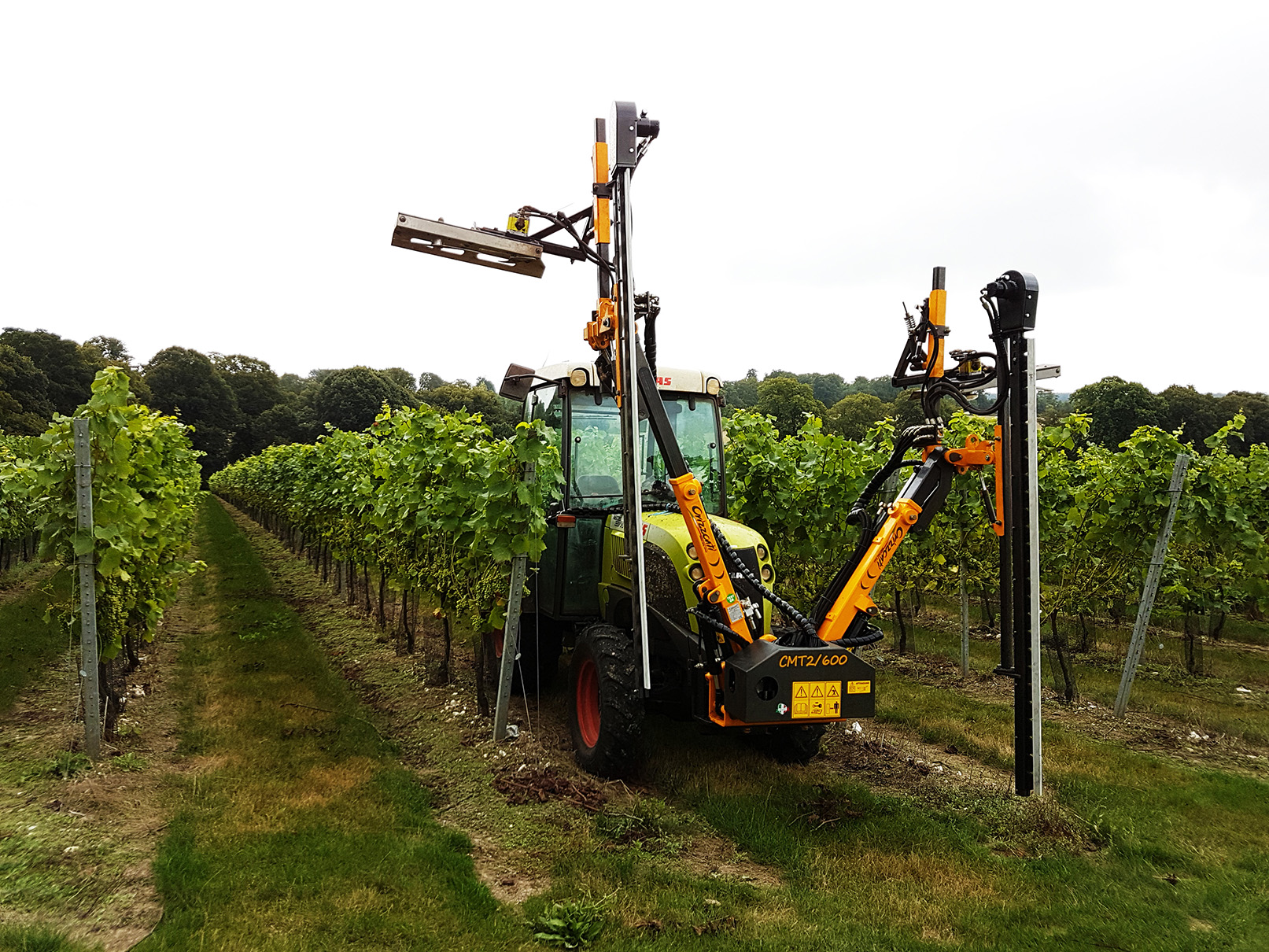
Orizzonti vine trimmer at Simpsons Wine Estate supplied by Kirkland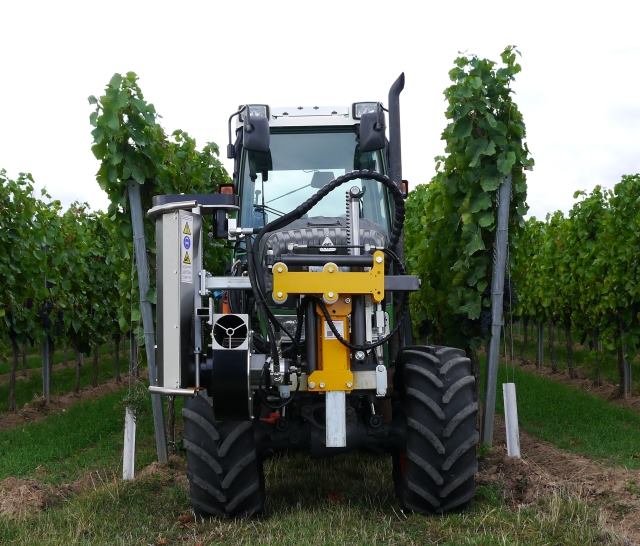
AWS Stockmeyer Deleafer 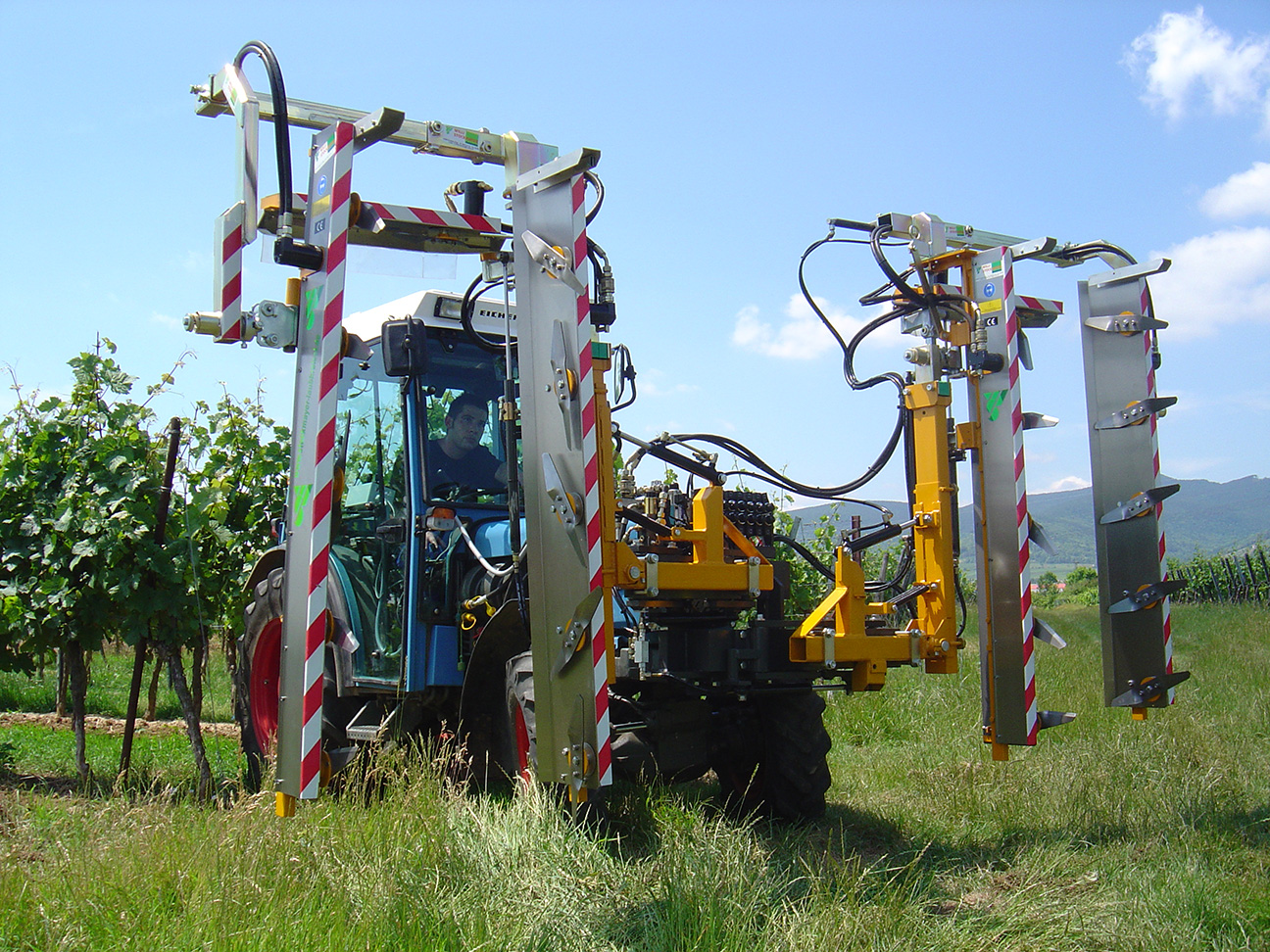
AWS Stockmeyer Vine trimmer two row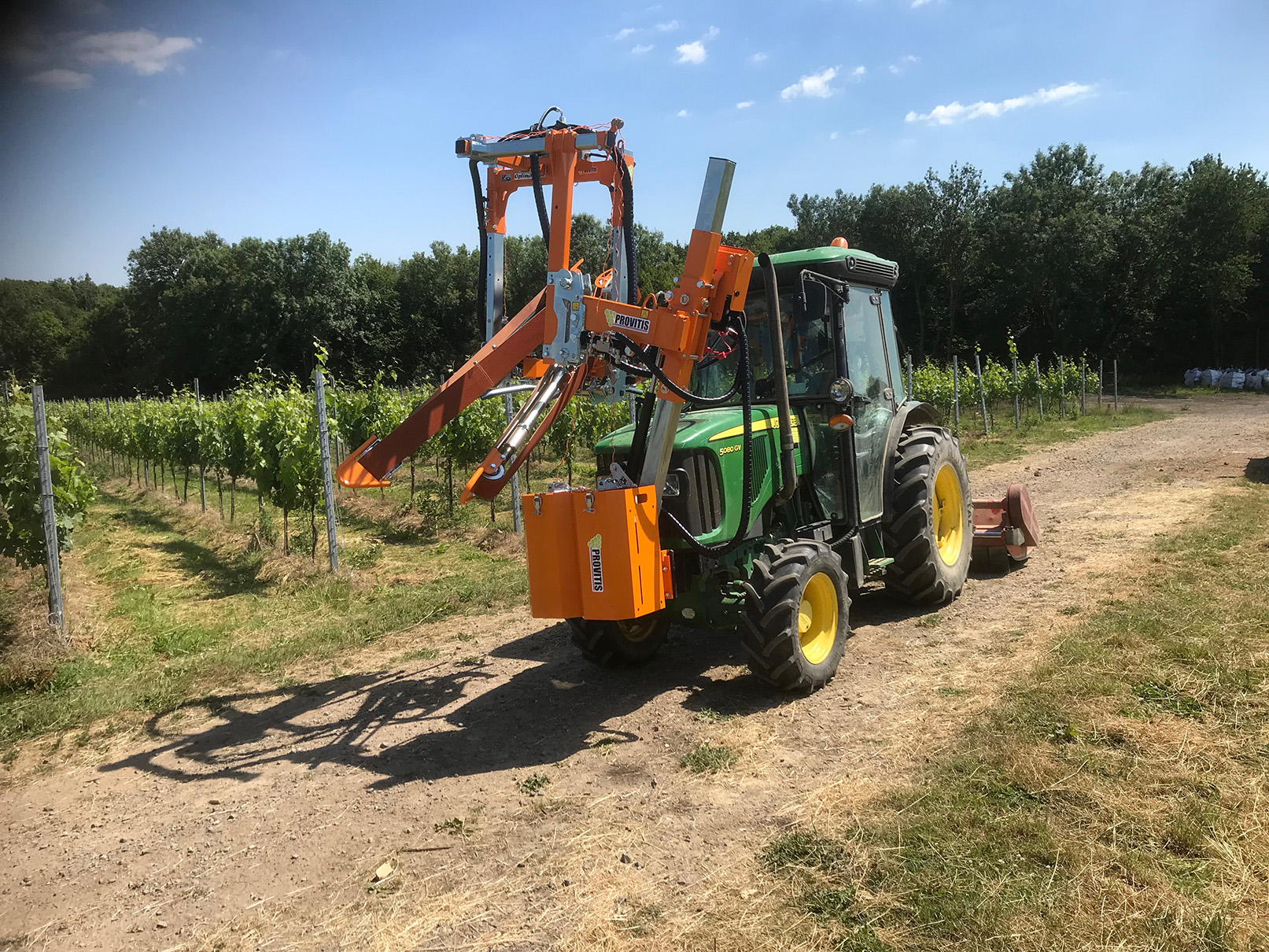
Provitis vine trimmer

